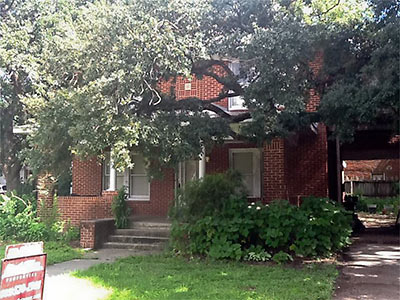
Those are some pretty hefty tree branches cutting across the front of the duplex listed for sale at 720 Bomar St. in East Montrose. And they’re from a pretty hefty tree — a giant oak that sits on the next lot over, a 3,500-sq.-ft. plot now known as Peggy Shiffick Park. A “for sale” sign appeared in the duplex’s front yard a few weeks ago, a reader tells Swamplot. “Rumors then started flying that the property had been bought, before it went in to the MLS system, by a builder (it is now pending in MLS) and that the existing grand old home on the property, which had been converted to a duplex and has been empty for years, will be torn down and townhomes built.”
***
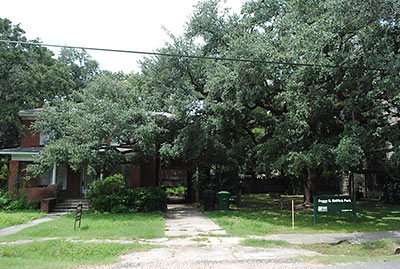
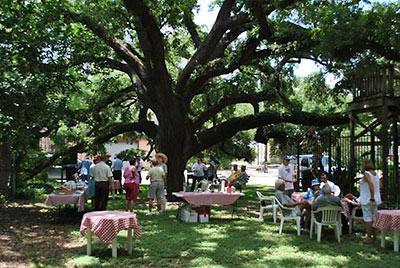
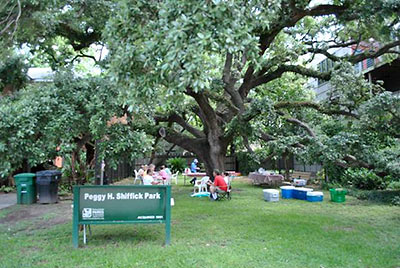
Shiffick ranks as one of Houston’s smallest parks, and the huge tree is clearly its main attraction. A couple of East Montrose neighbors tell Swamplot they’re imagining that if the house at 720 Bomar does get replaced with townhomes, it’ll require some heavy duty lopping off of the Shiffick Park oak’s over-reaching branches. Plus there’d be a slab covering parts of its root system, and the tree’s afternoon sun would be blocked. Two more large oaks currently sit on the duplex property, along Crocker St.:
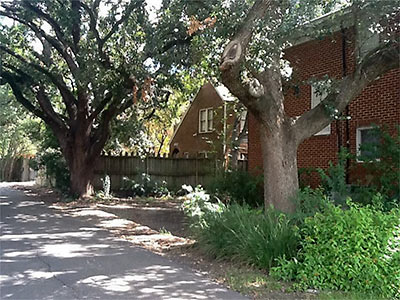
A proposal that the East Montrose Civic Association purchase the property and convert it to a neighborhood meeting place with office space to rent to the city never got very far, a neighbor tells Swamplot, because the organization didn’t have the money. The home is still listed at $350,000.
- 720 Bomar [HAR]
Photos: East Montrose Civic Association (Shiffick Park), HAR (720 Bomar St.)



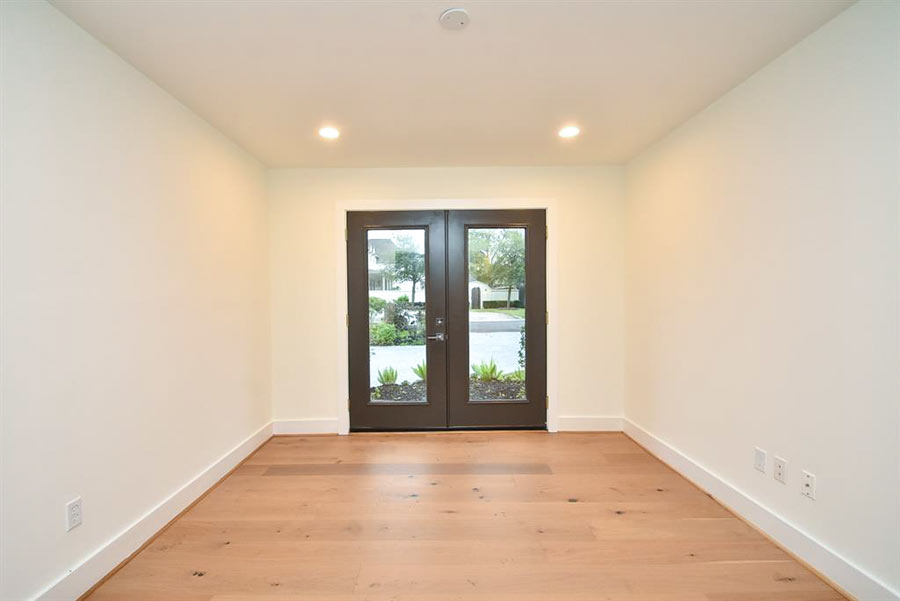

Argh
Isn’t there a rule saying that a neighbor can’t chop off so much of a neighbor’s tree as to kill it?
It’s obvious the Realtor expects the bldg to be demo’d – no interior pics at all.
ARP- The location of the tree trunk does not determine ownership of a tree. If a “neighbor’s tree hangs over your property, the portion of the tree that is contained within your property boundary belongs to you. You can do with it as you please. The same rule applies to a tree that hangs over the street. The City may do with it as it pleases.
$350k for a converted duplex. Doesn’t work for an income property and doesn’t really work for a single family due to the cost to convert it to back (codes/permits and just general cost… plus whatever might be needed inside plus the purchase cost…)
.
Sucks to see something like this go, but what other options are there? And it’s been empty for “years” ?
.
Buying it for neighborhood meetings sounds like a great idea, with some office space to offset most of the cost. They didn’t need to come up with $350k, just enough to get the loan. I know lending is stupid hard right now but out of everyone in the subdivision no one could help get a loan done (or raise $ and do a pooled private loan)?
.
Hate to say it but it seems they didn’t like the house *that* much or they could have gotten it.
The “bulder” better verify the deed restrictions because no matter what anyone has said or posted online the deed restrictions do not expire and cannot be changed with a simple veriance request. I have personally been provided with many of the original deed restriction paperwork from many of the inner-loop neighborhoods and they plainly read that most of the townhome developments are in clear violation and could face legal battles in the near future as more Houston residents grow tired of the mismanagement of the civil offices that were designed to protect us and the city. The City of Houston as for too long allowed “builders” to sell homes that never passed inspction so they have no certificate of occupancy much less approval to be built at all since most violate height restrictions and lot size minimum requirements, which cannot be changed with a variance, but require proper legal requests to be made to the entire group of home owners. It is time to wake up and play nice Houston otherwise it will be time to see you over developing townhouse builders in court…………
BTW thw title comapnies are required to disclose all the deed restrictions, mineral rights and height restrictions in the closing documents otherwise the title policy could be challeged and they could be held liable for non-disclosure causing this mess to begin with………
Houston has the entire East End setting undeveloped, with vacant, large lots so I am really sick of seeing stupid development in areas that look fine with bungalows or single family homes on normal lot sizes……… What is the deal? Is it a requitement to be insanely greedy to build inside the loop these days or really bad at building period because the new construction has really become a joke………. Those of you who have bought within the last 10 years, well most of you live in over-priced poorly built towers of architectural waste….
Charles,
Deed restrictions are strong, but there are many ways they can dissolve and expire.
Many portions of the West End, Rice Military, Shady Acres, and Cottage Grove would beg to differ on them not expiring.
They DO expire and have in several neighborhoods. The continuation is based upon the property owners agreeing to it. Only a couple of years ago I watched the neighborhood of Clark Pines (14th street area west of Durham) renew their deed restrictions.
If what you say is true, the planning commission and courts would be clogged with cases on this issue.
The City of Houston does not require a Certificate of Occupancy for residences.
Charles: why are they building in Montrose rather than the east end where land is cheap? That should be an easy question.
.
I’ll answer it with a question: where would you rather live? Or in case youre a rare exception; where would you rather be a home owner with a house to sell?
.
Builders, for the most part, follow demand. Now if they’re building stuff that goes against codes or deed restrictions I’m 100% on your side. But if they’re not, they’re just building to fill a demand. And that demand doesn’t exist in the east end.
though it might not seem (to some) like there is a demand on the east end for property right now, if people were smart enough to see beyond what’s just in front of them, then they would be buying up any property there that they can get their hands one before values skyrocket. A little seed called the Green line has been planted and will flourish that area quickly
EastMontrose is a civic association; dues aren’t required therefore money is limited. To buy the property would not only require the cost of downpayment, money would be needed to: renovate to be able to use as a commercial building(before it could generate income). monthly note. electricity. lawn maintenance. building maintenance. gas. property insurance. liability insurance. legal fees(just to set up the non-profit). To enter into the process would mean having fund raising in place going forward for many years just to cover costs.
Another option would be to purchase the property, tear down the building and add it to Peggy Shiffick Park. and BTW: Bill Shiffick bought the park property and donated it to the City of Houston expressly to save this tree.
EMCA had just reached the point in the past few years of being financially in a position to begin work on these ideas. It takes time, passion and commitment from a large number of people. And an even larger amount of money.
Very few neighborhoods in the Montrose area have deed restrictions, and even those that do, don’t regulate much more than religion or race (which is now illegal) or commercial. It is nearly impossible to get the required majority of property owners to agree to add new restrictions any many areas because of so many absentee property owners. The biggest historical issue has been the cost of suing offenders since there are no HOAs, thus requiring individuals to pursue any legal action on their own. Currently, about the only rules that must be followed are setback limits, and minimum lot sizes, but even the minimum lot size issue is also difficult to get a majority to agree to.
Historic preservation should apply to trees and in most cases probably does. But in reality historic preservation doesn’t apply when a developer wants the tree to go. Or when a developer wants an historic property in Fourth Ward to go.
The biggest shame is that we have a renovator who has rehabbed many homes right in our ‘hood (and does a mighty fine job, too, top quality work), who would have bought the house and saved it. He missed his chance by a mere few days… The house was not up for sale “for weeks”… No one knew it was going to go on the market, and when it did, it sold in a blink to a builder. At this point, all we can do is pray it’s a builder who renovates homes, not builds beige monster concrete jungles.
Several entire blocks in the south-western quadrant of East Montrose were recently sold, and a lot covered with about twenty 100-yr-old trees was razed, along with a darling bungalow. Now, fast as you can blink, architecturally-deficient 4-story monster homes that look like concrete block igloos are going up.
I’ve lived here since the ’80’s, and love my home, my neighborhood, and my neighbors. But the East End (Eastwood, that is) is starting to look better and better to me.
Since the beautiful tree in question is on city park property, wouldn’t it be prudent on the part of the developer to actually try to work ‘with’ the city somehow to preserve it??
I can’t imagine that anyone decent would willfully destroy such an asset.
Indeed, if the new construction were built around the tree branches, that could be used as a real selling point for a nice home. But construction is very hard on trees – Directly across the street is a development of new homes, and the property owner and architect specifically worked very hard to build around the huge tree on that lot and protect it during construction. It appeared that they had suceeded. But take a look at it today… the tree trunk is tall and fat … but there are only a few pom-pom sized clusters of leaves on the tree. It takes long time for a tree to die, and damage from construction may show up years later.
Civic club people here have contacted scores of resources (city, county, non-profits), and hopefully we’ll have help in minimizing damage to the tree, its branches, and its roots.
I lived in the East End in the 70-80’s in four different locations. Large sections of the area were pretty scary then, and are pretty scary now, but there are a couple of pockets that have historically done well – Idylwood being the prime example. After the market crash of 84, it took more than a decade for home values to recover, whereas the Museum district bounced back fairly quickly. The main issue with the area is lack of great shopping, restaurants, clubs, etc. and access – there basically are only two or three main accesses, and those are from I45 and Leeland from downtown. Until those issues are addressed, the Museum District will always do better. Interestingly, east was the main direction of growth in Houston until around the 1950’s, then it flipped to west. My parents, grandparents, great-grandparents, and great-great-grandparents all grew up and lived northeast, east, and southeast of downtown.